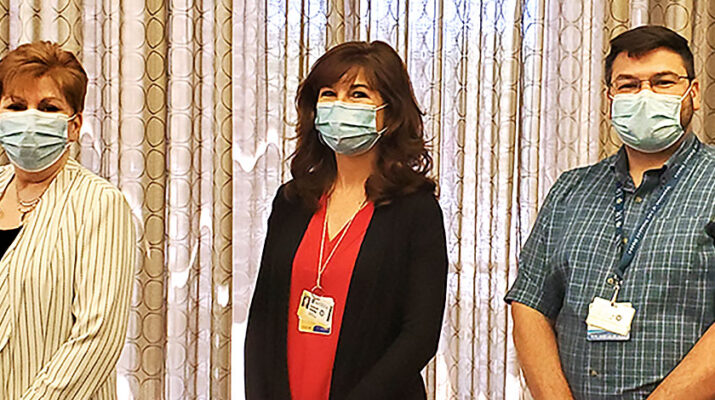By John Addyman
Three leaders at Friends of Strong Memorial – Director Sandy Arbasak, Interim Volunteer Program Manger Karen Keating, and Awareness and Events Coordinator Matt Ulakovic — discuss the work of volunteers, during and after the peak of COVID-19.
How did Strong operate without volunteers during COVID-19? Were there some instances where you had volunteers in certain areas?
Before the pandemic, our volunteer programs were really taking off, adding new roles in various areas. We had maybe 600 active volunteers at any given time working in 30-plus units. We had to abruptly pause all of our volunteer programs at the outset of the pandemic, when there were so many uncertainties about what was emerging.
It wasn’t until July of 2020 when we felt confident and safe in slowly welcoming back a very limited number of volunteers to five or six of our more meaningful service roles, such as patient discharge and in our main lobby. They’ve largely remained outside of inpatient areas, which still have limited visitation. With strict safety protocols in place, an estimated 170 dedicated volunteers have logged more than 10,000 hours since last July. Most recently we have been helping with primary care vaccinations with 125 volunteers — most are current volunteers in our pool we brought back — they have loved that. They started in January and have donated thousands of hours to that cause.
Surely volunteers wanted to come back before now, but were there some concerns, given COVID-19’s presence in the community?
Terrence Anderson said, “I strongly believe that everyone who walks this earth has a divine purpose in life and mine happens to be helping people. I don’t view volunteering during the pandemic as a challenge, but as a privilege and an honor to serve.”
Volunteer Mary Wagner said the pandemic brought lemons and lemonade. One advantage? “Getting a parking spot is easier than ever.” She also said interacting with the smaller pool of volunteers encouraged a stronger sense of comraderie. “I feel like I’m part of a family. With COVID, there are fewer of us, and I’ve had the opportunity to get to know other volunteers more closely. I really feel like I’m a valued part of the team.”
Hazel Pugh, volunteer coordinator for Wilmot Cancer Center, said when volunteers were not there last year, patients and staff asked how they were doing and when they would be able to come back: they were missed and appreciated. “It’s especially important for our patients to have our volunteers here again,” she said. “They’re always a bright light for patients, giving them an opportunity to have a brief friendly chat, an in-depth conversation or just get a little something to eat or drink during their time here. They’re great.”
We are extremely welcoming of all our volunteers; we’re very sad we can’t welcome everybody back right now.
Have you had inquiries about people coming back to serve?
We have heard from many of our preexperienced Friends of Strong volunteers, as well as some newly interested folks who’ve expressed a desire to help in any way they can. It’s truly been amazing to see the outpouring of support from so many people in our community. We regularly keep in touch with them via email and survey tools so we can keep them updated and let them know we are not yet prepared to restart all of our programs. We’re really focusing on a slow, thoughtful and safe approach to bringing individual volunteers back. We don’t want to turn people away, but unfortunately, right now, we just can’t bring in new volunteers.
We are receiving many inquiries about our popular summer high school volunteer program, but due to the safety precautions still in place, we are not able to offer that program this summer. We are hopeful that next year we will be able to welcome new volunteers and high school students back into our programs.
What kind of process does a volunteer go through before starting?
We start with an information session about our programs and the types of roles and responsibilities involved with volunteering in a healthcare setting. From there, they’re invited to complete an application, an interview, a background check, a health history review with one of our nurses, and then orientations and training programs to prepare them for success as a hospital volunteer. It’s a very robust onboarding process for the safety of our patients and for the volunteers.
Are there any requirements—vaccine, for instance?
No. At this time, COVID vaccination is not a requirement.
What’s the profile of a typical volunteer?
Our volunteers are civic-minded, humanitarian, charitable folks. Many are retired, while some are just looking to serve their community in their free time. We also see a lot of college students seeking ways to help the community, as well as gain valuable real-world, volunteer experience as they prepare to become contributing members of society—many with an eye toward healthcare careers; others just want to do something meaningful.
How do people raise their hand to volunteer?
When we are actively recruiting, our website fos.urmc.edu, directs them to call our office to sign up for a group information session during our recruitment periods, which are typically July through August, and December through January. For the summer high school program, students can begin looking for information on our website in early April 2022.
Photo: Friends of Strong Director Sandy Arbasak, Interim Volunteer Program Manager Karen Keating, and Awareness Event Coordinator Matt Ulakovic.

